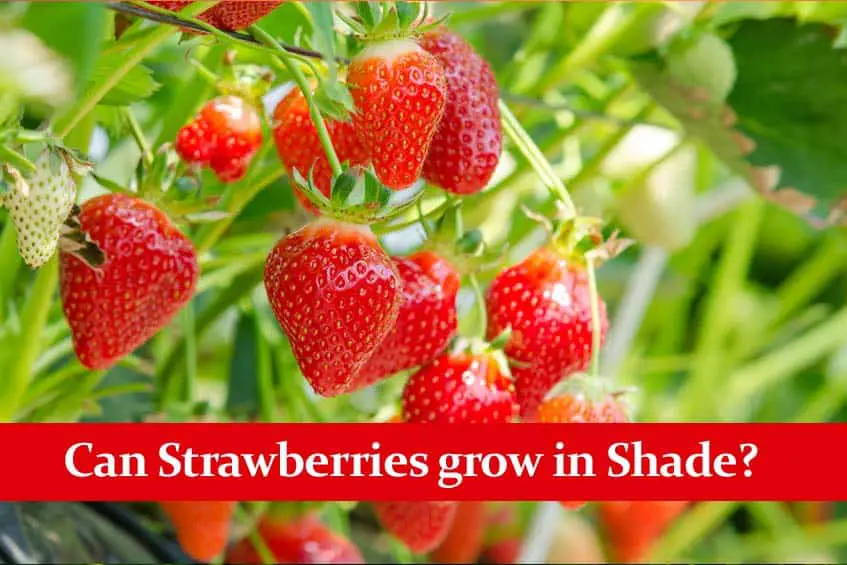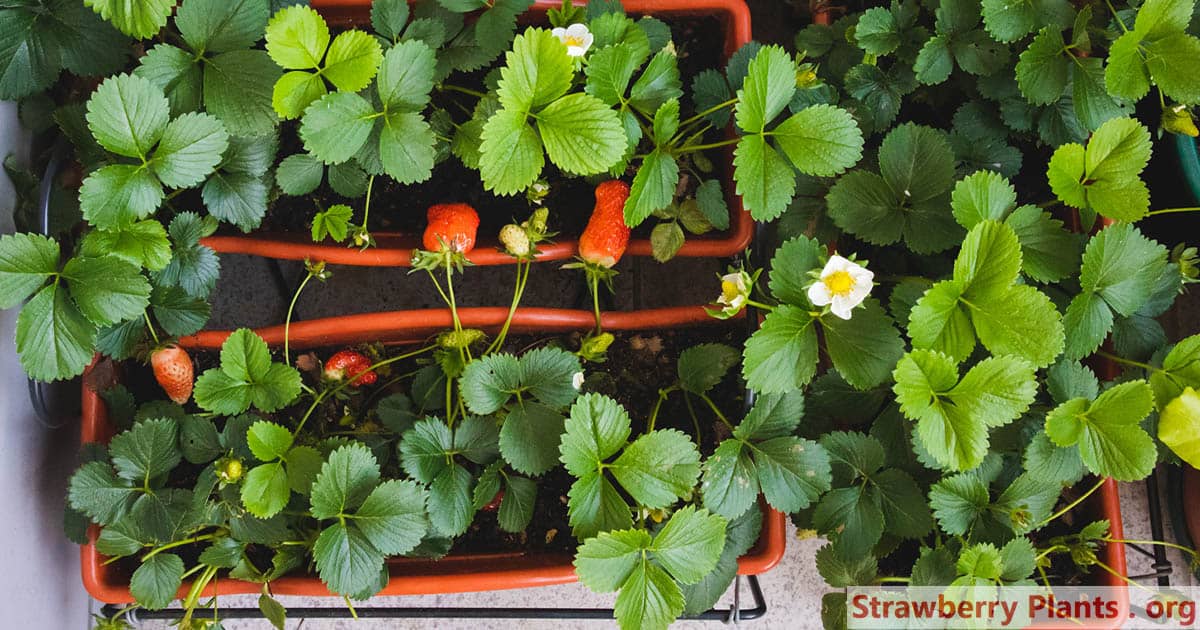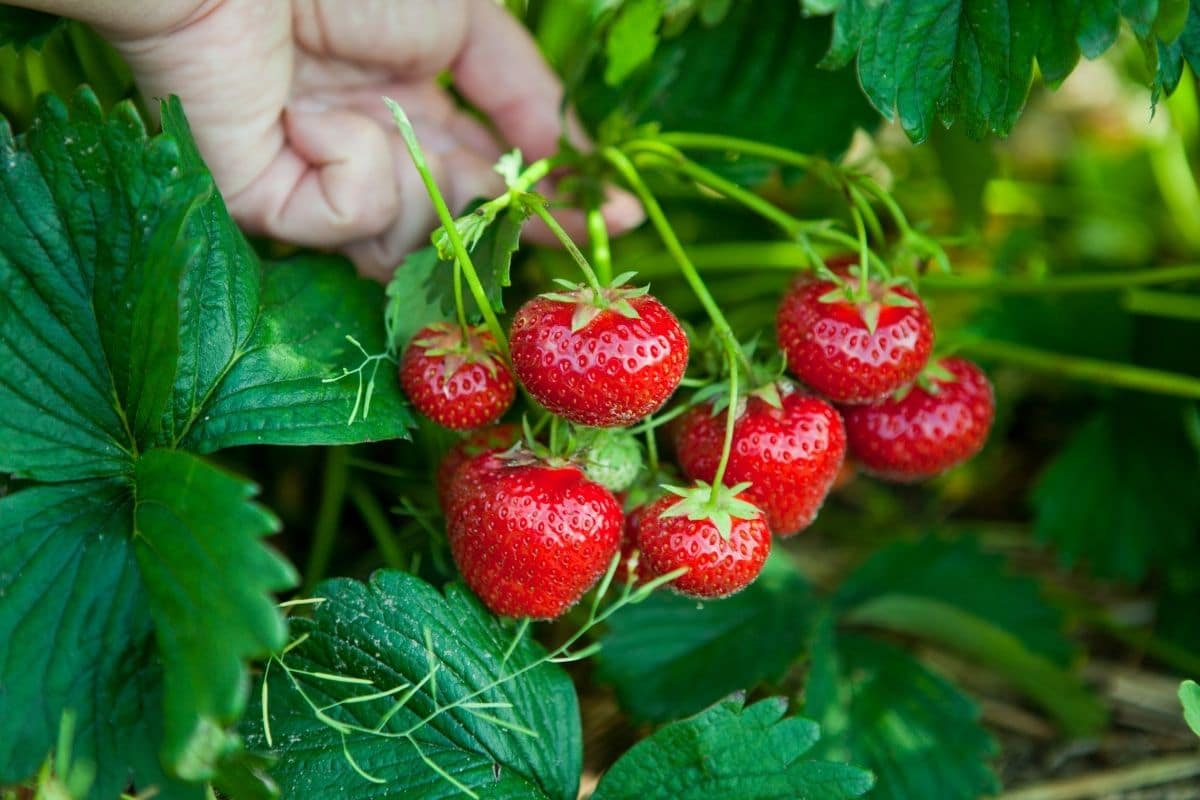Most gardening books say that strawberries need at least eight hours of sunshine every day to grow well, but the truth is that they can handle some shade, but not full shade. [feast_advanced_jump_to].
Strawberries are a delicious and versatile fruit that can be enjoyed fresh, baked into desserts, or used to flavor drinks and other foods While most strawberry plants thrive in full sun, some gardeners with shady yards wonder can strawberries grow in shade?
The short answer is yes! With the right variety selection, it is possible to grow strawberries in partial shade. While they do require at least 4-6 hours of direct sun per day, some shade-tolerant strawberry cultivars can still produce a modest harvest with less than the 8-10 hours of full sun preferred by most strawberry plants.
In this article, we’ll cover everything you need to know about successfully growing strawberries in the shade, including:
- The differences between shade-loving wild strawberries and full sun hybrids
- Recommended strawberry varieties for partial shade
- Tips for maximizing yields in shady gardens
- Ideal site selection and care for shade-grown strawberries
Let’s get started with the basics of how sun requirements differ between strawberry types.
Wild Strawberries vs. Hybrids: Why Some Thrive in Shade
There are two main types of strawberries when it comes to shade tolerance: wild strawberries and hybrid strawberries.
Wild Strawberries
Wild strawberries like alpine strawberries (Fragaria vesca) naturally grow in shaded forest areas and woodland edges across North America, Europe, and Asia. They are adapted to take advantage of small patches of dappled sunlight.
Alpine strawberries produce tiny, intensely flavored berries continuously throughout the growing season They form a compact mound of foliage rather than spreading aggressively via runners like hybrid varieties For gardens with partial shade, alpine strawberries are a perfect choice.
Other wild strawberries like woodland strawberries (Fragaria vesca ‘Semperflorens’) also make lovely groundcovers for shady spots. They produce modest yields of small, sweet berries from spring to fall.
Hybrid Strawberries
Hybrid strawberries most gardeners are familiar with are crosses between two wild strawberry species from North and South America (Fragaria virginiana and Fragaria chiloensis). We have breeders to thank for creating large, juicy, abundantly-fruiting hybrids like ‘Chandler’ and ‘Earliglow’.
However, these hybrids lose their vigor and crop potential in too much shade. Unlike wild types, they perform best in full sun with at least 8 hours of direct sunlight daily. But with thoughtful selection and care, some can still produce reasonably well in light shade.
Now that we’ve covered the reasons why wild strawberries tolerate shade better than most hybrids, let’s look at some recommended shade tolerant varieties.
Top Strawberry Variety Picks for Partial Shade
While no strawberry will fruit as heavily in shade versus full sun, the following varieties can still yield enough sweet berries to make growing them in shade worthwhile:
‘Alexandria’ Alpine Strawberry
This Fragaria vesca cultivar is the poster child for shade-tolerant strawberries. The compact, mound-forming plants produce pretty white flowers and loads of petite, aromatic berries all season long. With at least 4 hours of sun, ‘Alexandria’ alpine strawberry thrives and fruits steadily.
‘Lipstick’ Alpine Strawberry
Another dwarf alpine strawberry bred for hanging baskets and containers, ‘Lipstick’ boasts extra-large, ruby red berries with intense flavor. The plants only reach about 6 inches tall and can fruit continuously if kept picked. With some afternoon shade, ‘Lipstick’ yields impressively.
‘Yellow Wonder’ Alpine Strawberry
For something different, this golden-fruited alpine strawberry variety brightens up shady spots. The light yellow fruits have a milder sweetness that makes for a refreshing treat. The compact plants produce berries from early summer through fall.
‘Seascape’ Day-Neutral Strawberry
Day-neutral hybrids like ‘Seascape’ perform better in shade than June-bearing types, producing some fruit throughout the growing season. The large berries feature a glistening red exterior with ruby-red flesh. With at least 5-6 hours of sun, ‘Seascape’ will reward you with its good yields and disease resistance.
‘Toscana’ Day-Neutral Strawberry
This everbearing strawberry boasts extra-large, conical fruits with enticing fragrance and sweet, complex flavor. The compact, vigorous Italian variety thrives with 5-6 hours of sun and continues producing berries from summer until frost.
‘Tristar’ Day-Neutral Strawberry
Widely adapted and praised for its heavy yields and disease resistance, ‘Tristar’ is a wise choice for partially shaded gardens. Expect harvests of large, glossy red berries spring through fall given 4-6 hours of daily sun.
‘Mara des Bois’ June-Bearing Strawberry
While most June-bearers need full sun, this exceptionally flavorful French hybrid handles partial shade well. The small to mid-sized, pointed fruits have a rich, intensely sweet taste that shines through even in lighter yields. With about 5-6 hours of sun, ‘Mara des Bois’ will fruit reliably each early summer.
Now that we’ve covered some top shade-friendly strawberry varieties to try, let’s look at how to optimize your site and care for successful shade production.
Site Selection and Growing Tips for Shade-Loving Strawberries
To help your strawberries thrive in shade, keep these key site selection and care tips in mind:
-
Prioritize morning sun: Plants use morning light more efficiently for photosynthesis. Aim for an east-facing location.
-
Watch for reflected sunlight: Even if direct sun is limited, reflective surfaces like white walls can boost light.
-
Remove dense shade: Prune back overhanging branches or vegetation blocking available sunlight.
-
Improve drainage: Add organic matter like compost to help sandy or clay soils hold moisture but still drain well.
-
**Use raised beds:**Elevate planting rows or beds at least 6-12 inches to improve drainage and light exposure.
-
Space plants properly: Allow 12-15 inches between plants to prevent crowding and competition for sunlight.
-
Water consistently: Provide 1-2 inches of water per week, avoiding wet foliage which can lead to disease. Use drip irrigation or soaker hoses.
-
Use shade fabrics: Drape insect netting or shade cloth to provide filtered light and protect from birds. Remove once fruit ripens.
-
Weed vigilantly: Reduce competition from weeds which will otherwise steal light and moisture. Apply mulch to suppress weeds.
-
Prune off runners: Removing runners on hybrids helps concentrate energy into fruit production rather than plant growth.
-
Renew plants promptly: Replant strawberry beds every 3-4 years once yields start declining.
The Final Word on Growing Strawberries in Shade
Full sun may be ideal, but with the right varieties and care, it is possible to successfully grow strawberries in shade. Focus on shade-tolerant alpine and day-neutral types that can produce with as little as 4-6 hours of direct sunlight.
Make the most of the available light by elevating beds, removing dense shade, and maintaining plants diligently. While overall yields will be lower than in full sun, the sweet berries you harvest from the shade will be well worth savoring.
So don’t despair if your yard is shady – you can still reap a bountiful (if smaller) strawberry harvest. With this guide’s tips on shade-loving varieties, proper site selection, and attentive care, your shaded strawberry patch can thrive and fruit to provide you with a delightful dose of homegrown, sun-kissed flavor.

How Much Shade Can Strawberries Tolerate?
For strawberries to grow big, tasty fruit every day, they need at least five hours of direct sunlight. It’s possible for strawberry flowers to bloom in even less light, but the strawberries they make will be small, wet, and sour.
Dr. Hyo Gil Choi at Kongju University in South Korea studied the light requirements of strawberries grown in the winter in greenhouses with different amounts of sun exposure. He left some strawberry plants completely shaded by curtains until 10 o’clock every morning, some strawberry plants completely shaded by curtains until noon, and some strawberry plants completely shaded by curtains until 2 o’clock in the afternoon. He also had strawberry plants he allowed to receive full sunshine.
In this part of Korea, the sun rises around 7 a.m. and goes down before 5 p.m. This means that the strawberry plants received 10, seven, five, or three hours of sun every day. Any amount of sunlight, even three hours a day, is better for the strawberry plants than none at all.
Dr. Choi discovered that the strawberry plants that received the least light made the most chlorophyll. They had unusually dark-green leaves. It was as if they were trying extra hard to use all the sunlight they received.
The Korean researcher also found that berries grown in different light conditions were very different in size and sugar content, but not in how acidic they were. The strawberries grown with just three hours of sun every day were small and tart. The strawberries grown in full sunlight were bigger and had greater sugar content.
Here is a summary of his results:
- Strawberry plants that got full sun were about 50% bigger than strawberry plants that got little light.
- Strawberry plants that got the most shade had four times as many “tiny” strawberries (less than 10 grams, or 1/3 of an ounce) as plants that got full sun.
- Strawberry plants that got full sun had up to 50% more fructose, glucose, and sucrose sugars than strawberry plants that got the least shade.
- Strawberry plants that were in the shade had the same amount of acetic acid (the acid in vinegar) as strawberry plants that were in the sun. They had strawberry tartness without the full strawberry sweetness.
Dr. Choi’s findings confirm what a lot of home gardeners already know. Strawberries grown in shade are small and tart. That doesn’t mean you shouldn’t grow them; it just means you should expect them to be different sizes and tastes.

Can Strawberries Grow in Total Shade?
It’s not hard to find photos and videos of strawberry plants growing in total shade under fruit trees. If you plant strawberries in well-drained, highly fertilized soil that doesn’t have any weeds, they can grow dense, dark green leaves even if they don’t get any direct sunlight.
Strawberries grown in complete shade often have unusually large leaves. They even made a few flowers. Not many strawberries, though, will actually bear fruit until the sun is high enough that plants even those that are growing under trees get several hours of sunlight every day.

On the other hand, strawberry plants grown in greenhouses in sunny desert places like Arizona and the central part of Southern California need shade every day to keep them from getting sunburned. In these locations, it may be impossible to keep strawberry plants going through the entire summer. Around the first week of summer, light and heat prove to be too much for these strawberry plants.
Not only does having the right amount of sun and shade help strawberries grow well, but it also makes the leaves look nice.
Growing Strawberries in Shade (Amazing Growth)
FAQ
Are strawberries ok in the shade?
What happens if strawberries dont get enough sun?
What is the minimum sunlight for strawberries?
Do strawberries need protection from sun?
Can strawberries grow in shade?
Strawberry lovers with shaded yards rejoice because, yes, you can grow strawberries in shade, provided you select shady strawberry varieties. Interested in growing strawberries in shade? Read on to learn about shade tolerant strawberry varieties.
How do you grow strawberries in a shade?
Stick your finger 1-2 inches below the surface and if it is dry, add some more water to the soil. Avoid keeping the crown or the central stem of the strawberry too wet otherwise it can rot. Shade grown strawberries will keep moist for longer and channel more water into growing the strawberry fruit. My strawberries growing well in shade.
What are wild strawberries for shade?
Wild strawberries are the type of strawberries for shade. When we are talking wild strawberry for shade, we are speaking of alpine strawberries. Alpine strawberries grow wild along the perimeters of forests in Europe, North and South America, northern Asia, and Africa. Alpine strawberries (Fragaria vesca) for shade do not send out runners.
Do strawberries grow in full sun?
Strawberries grown in full sunlight were about 50 percent larger than strawberries grown in low-light conditions. There were four times as many “tiny” strawberries (weighing less than 10 grams, about 1/3 of an ounce) on the plants grown in the most shade as on the plants grown in full sun.
How much sunlight does a strawberry need?
The strawberries grown with just three hours of sun every day were small and tart. The strawberries grown in full sunlight were bigger and had greater sugar content. Here is a summary of his results: Strawberries grown in full sunlight were about 50 percent larger than strawberries grown in low-light conditions.
Do Alpine strawberries grow in shade?
‘Yellow Wonder,’ a yellow alpine strawberry, is also said to do fairly well in shade. In either case, just be aware that alpine strawberries do not fruit as prolifically as the larger hybrid varieties. When they do fruit, however, they are absolutely sublime and the perfect type of strawberries to grow in shade.
- A Complete Guide to Caring for Yuki Cherry Blossom Shrub - January 23, 2025
- Identifying Red Hot Poker Seeds: What to Look For When Harvesting Torch Lily Pods - January 23, 2025
- A Complete Guide to Harvesting Evening Primrose Seeds - January 23, 2025
